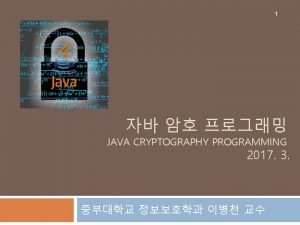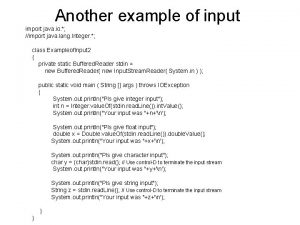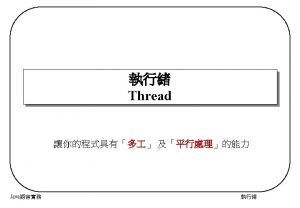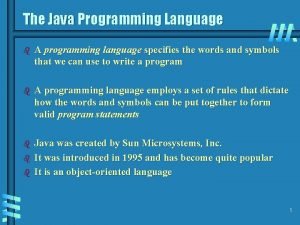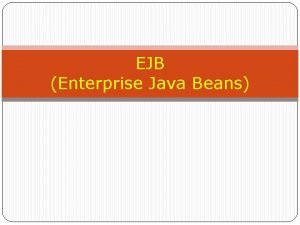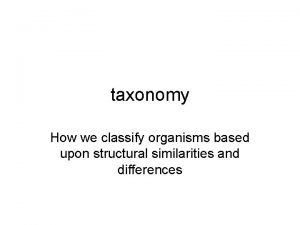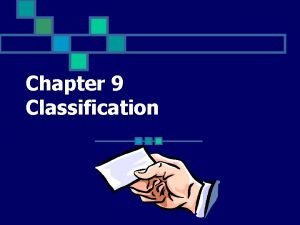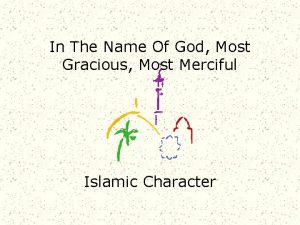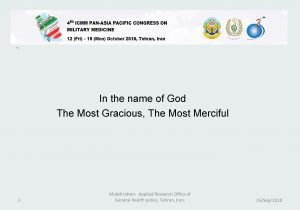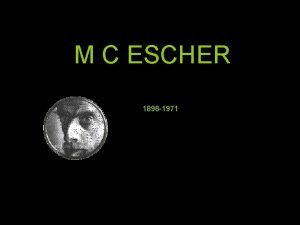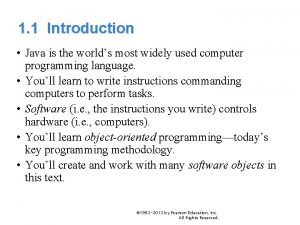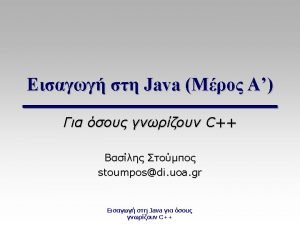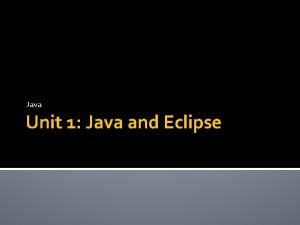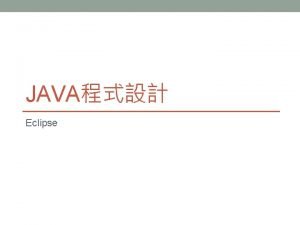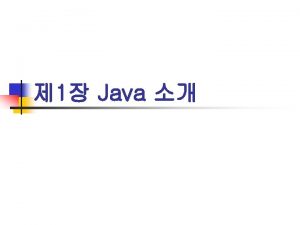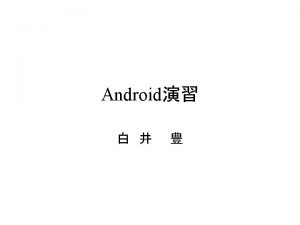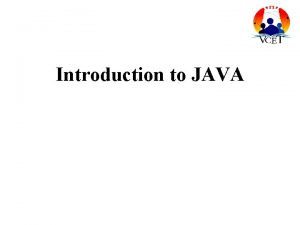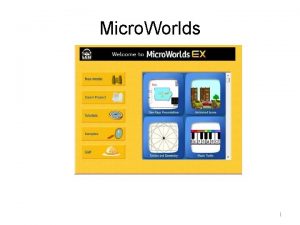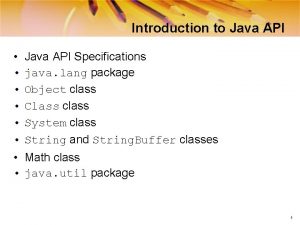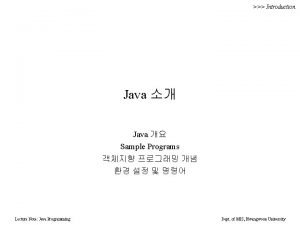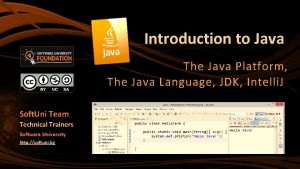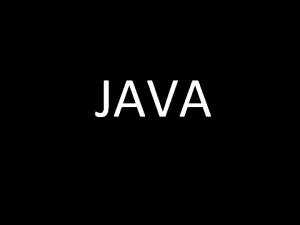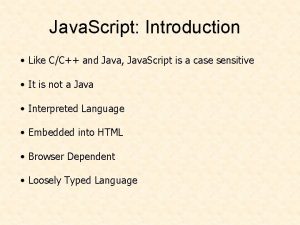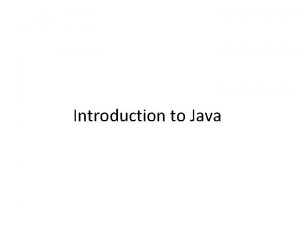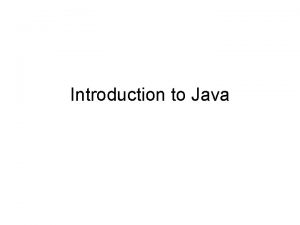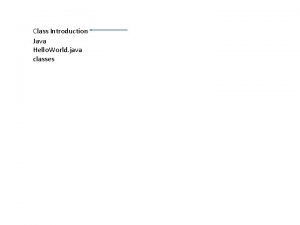1 1 Introduction Java is the worlds most













































































- Slides: 77

1. 1 Introduction • Java is the world’s most widely used computer programming language. • You’ll learn to write instructions commanding computers to perform tasks. • Software (i. e. , the instructions you write) controls hardware (i. e. , computers). • You’ll learn object-oriented programming—today’s key programming methodology. • You’ll create and work with many software objects in this text. © 1992 -2012 by Pearson Education, Inc. All Rights Reserved.

1. 1 Introduction (Cont. ) • Java is the preferred language for meeting many organizations’ enterprise programming needs. • Java has become the language of choice for implementing Internet-based applications and software for devices that communicate over a network. • In use today are more than a billion general-purpose computers and billions more Java-enabled cell phones, smartphones and handheld devices (such as tablet computers). © 1992 -2012 by Pearson Education, Inc. All Rights Reserved.

1. 1 Introduction (Cont. ) • The number of mobile Internet users will reach approximately 134 million by 2013. • Smartphone sales are projected to surpass personal computer sales in 2011 and tablet sales to account for over 20% of all personal computer sales by 2015. • By 2014, the smartphone applications market is expected to exceed $40 billion, which is creating significant opportunities for programming mobile applications. © 1992 -2012 by Pearson Education, Inc. All Rights Reserved.

1. 1 Introduction (Cont. ) • Java Editions: SE, EE and ME – Covers Java Standard Edition 6 (Java SE 6) with optional modules on the new features of Java SE 7 – Used for developing cross-platform, generalpurpose applications. – Java is used in such a broad spectrum of applications that it has two other editions. – The Java Enterprise Edition (Java EE) – Geared toward developing large-scale, distributed networking applications and web-based applications. © 1992 -2012 by Pearson Education, Inc. All Rights Reserved.

1. 1 Introduction (Cont. ) – Java Micro Edition (Java ME) – geared toward developing applications for small, memory-constrained devices, such as Black. Berry smartphones. – Google’s Android operating system – used on numerous smartphones, tablets (small, lightweight mobile computers with touch screens), e-readers and other devices—uses a customized version of Java not based on Java ME. © 1992 -2012 by Pearson Education, Inc. All Rights Reserved.

1. 9 Java and a Typical Java Development Environment (Cont. ) • Java Class Libraries – Rich collections of existing classes and methods – Also known as the Java APIs (Application Programming Interfaces). © 1992 -2012 by Pearson Education, Inc. All Rights Reserved.

© 1992 -2012 by Pearson Education, Inc. All Rights Reserved.

Networks • A network is two or more computers that are connected so that data and resources can be shared • Most computers are connected to some kind of network • Each computer has its own network address, which uniquely identifies it among the others • A file server is a network computer dedicated to storing programs and data that are shared among network users Copyright © 2012 Pearson Education, Inc.

Network Connections • Each computer in a network could be directly connected to every other computer in the network • These are called point-to-point connections Adding a computer requires a new communication line for each computer already in the network This technique is not practical for more than a few close machines Copyright © 2012 Pearson Education, Inc.

Network Connections • Most networks share a single communication line • Adding a new computer to the network is relatively easy Network traffic must take turns using the line, which introduces delays Often information is broken down in parts, called packets, which are sent to the receiving machine and then reassembled Copyright © 2012 Pearson Education, Inc.

A Computer Network Copyright © 2012 Pearson Education, Inc.

Local-Area Networks A Local-Area Network (LAN) covers a small distance and a small number of computers LAN A LAN often connects the machines in a single room or building Copyright © 2012 Pearson Education, Inc.

Wide-Area Networks A Wide-Area Network (WAN) connects two or more LANs, often over long distances LAN Copyright © 2012 Pearson Education, Inc.

The Internet • The Internet is a WAN which spans the planet • The word Internet comes from the term internetworking • It started as a United States government project, sponsored by the Advanced Research Projects Agency (ARPA) – originally it was called the ARPANET • The Internet grew quickly throughout the 1980 s and 90 s Copyright © 2012 Pearson Education, Inc.

TCP/IP • A protocol is a set of rules that determine how things communicate with each other • The software that manages Internet communication follows a suite of protocols called TCP/IP • The Internet Protocol (IP) determines the format of the information as it is transferred • The Transmission Control Protocol (TCP) dictates how messages are reassembled and handles lost information Copyright © 2012 Pearson Education, Inc.

IP and Internet Addresses • Each computer on the Internet has a unique IP address, such as: 204. 192. 116. 2 • Most computers also have a unique Internet name, which also is referred to as an Internet address: hector. vt. edu kant. gestalt-llc. com • The first part indicates a particular computer (hector) Copyright © 2012 Pearson Education, Inc.

Domain Names • The last part of a domain name, called a top-level domain (TLD), supposedly indicates the type of organization: edu com org net Sometimes the suffix indicates the country: uk au ca se United Kingdom Australia Canada Sweden educational institution commercial entity non-profit organization network-based organization Additional TLDs have been added: biz, info, tv, name Copyright © 2012 Pearson Education, Inc.

Domain Names • A domain name can have several parts • Unique domain names mean that multiple sites can have individual computers with the same local name • When used, an Internet address is translated to an IP address by software called the Domain Name System (DNS) • There is no one-to-one correspondence between the sections of an IP address and the sections of an Internet address Copyright © 2012 Pearson Education, Inc.

The World Wide Web • The World Wide Web allows many different types of information to be accessed using a common interface • A browser is a program which accesses network resources and presents them – Popular browsers: Internet Explorer, Safari, Firefox • Resources presented include: – text, graphics, video, sound, audio, executable programs • A Web document usually contains links to other Web documents, creating a hypermedia environment • The term Web comes from the fact that information is not organized in a linear fashion Copyright © 2012 Pearson Education, Inc.

The World Wide Web • Web documents are often defined using the Hyper. Text Markup Language (HTML) • Information on the Web is found using a Uniform Resource Locator (URL): http: //www. cnn. com http: //www. vt. edu/student_life/index. html ftp: //java. sun. com/applets/animation. zip • A URL specifies a protocol (http), a domain, and possibly specific documents Copyright © 2012 Pearson Education, Inc.

Outline Computer Processing Hardware Components Networks The Java Programming Language Program Development Object-Oriented Programming Copyright © 2012 Pearson Education, Inc.

Java • The Java programming language was created by Sun Microsystems, Inc. • It was introduced in 1995 and it's popularity has grown quickly since • A programming language specifies the words and symbols that we can use to write a program • A programming language employs a set of rules that dictate how the words and symbols can be put together to form valid program statements Copyright © 2012 Pearson Education, Inc.

Java Program Structure • In the Java programming language: – A program is made up of one or more classes – A class contains one or more methods – A method contains program statements • These terms will be explored in detail throughout the course • A Java application always contains a method called main • See Lincoln. java Copyright © 2012 Pearson Education, Inc.

//********************************** // Lincoln. java Author: Lewis/Loftus // // Demonstrates the basic structure of a Java application. //********************************** public class Lincoln { //--------------------------------// Prints a presidential quote. //--------------------------------public static void main (String[] args) { System. out. println ("A quote by Abraham Lincoln: "); System. out. println ("Whatever you are, be a good one. "); } } Copyright © 2012 Pearson Education, Inc.

Output //********************************** A quote Author: by Abraham Lincoln: // Lincoln. java Lewis/Loftus // Whatever you are, be a good one. // Demonstrates the basic structure of a Java application. //********************************** public class Lincoln { //--------------------------------// Prints a presidential quote. //--------------------------------public static void main (String[] args) { System. out. println ("A quote by Abraham Lincoln: "); System. out. println ("Whatever you are, be a good one. "); } } Copyright © 2012 Pearson Education, Inc.

Java Program Structure // comments about the class public class My. Program { class header class body Comments can be placed almost anywhere } Copyright © 2012 Pearson Education, Inc.

Java Program Structure // comments about the class public class My. Program { // comments about the method public static void main (String[] args) { method body method header } } Copyright © 2012 Pearson Education, Inc.

Comments • Comments should be included to explain the purpose of the program and describe processing steps • They do not affect how a program works • Java comments can take three forms: // this comment runs to the end of the line /* this comment runs to the terminating symbol, even across line breaks /** this is a javadoc comment */ */ Copyright © 2012 Pearson Education, Inc.

Identifiers • Identifiers are the "words" in a program • A Java identifier can be made up of letters, digits, the underscore character ( _ ), and the dollar sign • Identifiers cannot begin with a digit • Java is case sensitive: Total, total, and TOTAL are different identifiers • By convention, programmers use different case styles for different types of identifiers, such as – title case for class names - Lincoln – upper case for constants - MAXIMUM Copyright © 2012 Pearson Education, Inc.

Identifiers • Sometimes the programmer chooses the identifer(such as Lincoln) • Sometimes we are using another programmer's code, so we use the identifiers that he or she chose (such as println) • Often we use special identifiers called reserved words that already have a predefined meaning in the language • A reserved word cannot be used in any other way Copyright © 2012 Pearson Education, Inc.

Reserved Words • The Java else reserved words: abstract interface assert boolean break byte case catch char class const continue default do double enum extends false finally float for goto if implements import instanceof int long native new null package private protected public return short static strictfp super switch synchronized this throws transient true try void volatile while Copyright © 2012 Pearson Education, Inc.

Quick Check Which of the following are valid Java identifiers? grade quiz. Grade Network. Connection frame 2 3 rd. Test. Score MAXIMUM MIN_CAPACITY student# Shelves 1&2 Copyright © 2012 Pearson Education, Inc.

Quick Check Which of the following are valid Java identifiers? grade Valid quiz. Grade Valid Network. Connection Valid frame 2 Valid 3 rd. Test. Score Invalid – cannot begin with a digit MAXIMUM Valid MIN_CAPACITY Valid student# Invalid – cannot contain the '#' character Shelves 1&2 Invalid – cannot contain the '&' character Copyright © 2012 Pearson Education, Inc.


1. 9 Java and a Typical Java Development Environment • Microprocessors are having a profound impact in intelligent consumer-electronic devices. • 1991 – Recognizing this, Sun Microsystems funded an internal corporate research project led by James Gosling, which resulted in a C++-based object-oriented programming language Sun called Java. – Key goal of Java is to be able to write programs that will run on a great variety of computer systems and computer-control devices. – This is sometimes called “write once, run anywhere. ” © 1992 -2012 by Pearson Education, Inc. All Rights Reserved.

1. 9 Java and a Typical Java Development Environment (Cont. ) • 1993 – The web exploded in popularity – Sun saw the potential of using Java to add dynamic content to web pages. • Java garnered the attention of the business community because of the phenomenal interest in the web. • Java is used to develop large-scale enterprise applications, to enhance the functionality of web servers, to provide applications for consumer devices and for many other purposes. © 1992 -2012 by Pearson Education, Inc. All Rights Reserved.

1. 9 Java and a Typical Java Development Environment (Cont. ) • Sun Microsystems was acquired by Oracle in 2009. • As of 2010 97% of enterprise desktops, three billion handsets, and 80 million television devices run Java. • Java is the most widely used software development language in the world. © 1992 -2012 by Pearson Education, Inc. All Rights Reserved.

1. 9 Java and a Typical Java Development Environment (Cont. ) • Java Class Libraries – Rich collections of existing classes and methods – Also known as the Java APIs (Application Programming Interfaces). © 1992 -2012 by Pearson Education, Inc. All Rights Reserved.

© 1992 -2012 by Pearson Education, Inc. All Rights Reserved.

© 1992 -2012 by Pearson Education, Inc. All Rights Reserved.

1. 9 Java and a Typical Java Development Environment (Cont. ) • Java programs normally go through five phases – edit – compile – load – verify – execute. • Download the JDK and its documentation from – www. oracle. com/technetwork/javase/downloads /index. html. • Read the Before You Begin section of this book to ensure that you set up your computer properly to compile and execute Java programs. • Visit Oracle’s New to Java Center at: • www. oracle. com/technetwork/topics/newtojava/ov erview/index. html © 1992 -2012 by Pearson Education, Inc. All Rights Reserved.

1. 9 Java and a Typical Java Development Environment (Cont. ) • Phase 1 consists of editing a file with an I – Type a Java program (source code) using the editor. – Make any necessary corrections. – Save the program. – A file name ending with the. java extension indicates that the file contains Java source code. © 1992 -2012 by Pearson Education, Inc. All Rights Reserved.

© 1992 -2012 by Pearson Education, Inc. All Rights Reserved.

1. 9 Java and a Typical Java Development Environment (Cont. ) • Linux editors: vi and emacs. • Windows editors: – Notepad – Edit. Plus (www. editplus. com) – Text. Pad (www. textpad. com) – j. Edit (www. jedit. org). • Integrated development environments (IDEs) – Provide tools that support the software development process, including editors for writing and editing programs and debuggers for locating logic errors—errors that cause programs to execute incorrectly. © 1992 -2012 by Pearson Education, Inc. All Rights Reserved.

1. 9 Java and a Typical Java Development Environment (Cont. ) • Popular IDEs – Eclipse (www. eclipse. org) – Net. Beans (www. netbeans. org). – j. GRASP™ IDE (www. jgrasp. org) – Dr. Java IDE (www. drjava. org/download. shtml) – Blue. J IDE (www. bluej. org/) – Text. Pad® Text Editor for Windows® (www. textpad. com/) © 1992 -2012 by Pearson Education, Inc. All Rights Reserved.

1. 9 Java and a Typical Java Development Environment (Cont. ) • Phase 2: Compiling a Java Program into Bytecodes – Use the command javac (the Java compiler) to compile a program. For example, to compile a program called Welcome. java, you’d type • javac Welcome. java – If the program compiles, the compiler produces a. class file called Welcome. class that contains the compiled version of the program. © 1992 -2012 by Pearson Education, Inc. All Rights Reserved.

© 1992 -2012 by Pearson Education, Inc. All Rights Reserved.

1. 9 Java and a Typical Java Development Environment (Cont. ) • Java compiler translates Java source code into bytecodes that represent the tasks to execute. • Bytecodes are executed by the Java Virtual Machine (JVM)— a part of the JDK and the foundation of the Java platform. • Virtual machine (VM)—a software application that simulates a computer – Hides the underlying operating system and hardware from the programs that interact with it. • If the same VM is implemented on many computer platforms, applications that it executes can be used on all those platforms. © 1992 -2012 by Pearson Education, Inc. All Rights Reserved.

1. 9 Java and a Typical Java Development Environment (Cont. ) • Bytecodes are platform independent – They do not depend on a particular hardware platform. • Bytecodes are portable – The same bytecodes can execute on any platform containing a JVM that understands the version of Java in which the bytecodes were compiled. • The JVM is invoked by the java command. For example, to execute a Java application called Welcome, you’d type the command • java Welcome © 1992 -2012 by Pearson Education, Inc. All Rights Reserved.

1. 9 Java and a Typical Java Development Environment (Cont. ) • Phase 3: Loading a Program into Memory – The JVM places the program in memory to execute it—this is known as loading. – Class loader takes the. class files containing the program’s bytecodes and transfers them to primary memory. – Also loads any of the. class files provided by Java that your program uses. • The. class files can be loaded from a disk on your system or over a network. © 1992 -2012 by Pearson Education, Inc. All Rights Reserved.

© 1992 -2012 by Pearson Education, Inc. All Rights Reserved.

1. 9 Java and a Typical Java Development Environment (Cont. ) • Phase 4: Bytecode Verification – As the classes are loaded, the bytecode verifier examines their bytecodes – Ensures that they’re valid and do not violate Java’s security restrictions. • Java enforces strong security to make sure that Java programs arriving over the network do not damage your files or your system (as computer viruses and worms might). © 1992 -2012 by Pearson Education, Inc. All Rights Reserved.

© 1992 -2012 by Pearson Education, Inc. All Rights Reserved.

1. 9 Java and a Typical Java Development Environment (Cont. ) • Phase 5: Execution – The JVM executes the program’s bytecodes. – JVMs typically execute bytecodes using a combination of interpretation and so-called just-in-time (JIT) compilation. – Analyzes the bytecodes as they’re interpreted – A just-in-time (JIT) compiler—known as the Java Hot. Spot compiler—translates the bytecodes into the underlying computer’s machine language. © 1992 -2012 by Pearson Education, Inc. All Rights Reserved.

1. 9 Java and a Typical Java Development Environment (Cont. ) – When the JVM encounters these compiled parts again, the faster machine-language code executes. – Java programs go through two compilation phases – One in which source code is translated into bytecodes (for portability across JVMs on different computer platforms) and – A second in which, during execution, the bytecodes are translated into machine language for the actual computer on which the program executes. • © 1992 -2012 by Pearson Education, Inc. All Rights Reserved.

© 1992 -2012 by Pearson Education, Inc. All Rights Reserved.


Outline Computer Processing Hardware Components Networks The Java Programming Language Program Development Object-Oriented Programming Copyright © 2012 Pearson Education, Inc.

Program Development • The mechanics of developing a program include several activities: – writing the program in a specific programming language (such as Java) – translating the program into a form that the computer can execute – investigating and fixing various types of errors that can occur • Software tools can be used to help with all parts of this process Copyright © 2012 Pearson Education, Inc.

Language Levels • There are four programming language levels: – – machine language assembly language high-level language fourth-generation language • Each type of CPU has its own specific machine language • The other levels were created to make it easier for a human being to read and write programs Copyright © 2012 Pearson Education, Inc.

Programming Languages • Each type of CPU executes only a particular machine language • A program must be translated into machine language before it can be executed • A compiler is a software tool which translates source code into a specific target language • Often, that target language is the machine language for a particular CPU type • The Java approach is somewhat different Copyright © 2012 Pearson Education, Inc.

Java Translation • The Java compiler translates Java source code into a special representation called bytecode • Java bytecode is not the machine language for any traditional CPU • Another software tool, called an interpreter, translates bytecode into machine language and executes it • Therefore the Java compiler is not tied to any particular machine • Java is considered to be architecture-neutral Copyright © 2012 Pearson Education, Inc.

Java Translation Java source code Java compiler Java bytecode Bytecode interpreter Bytecode compiler Machine code Copyright © 2012 Pearson Education, Inc.

Development Environments • There are many programs that support the development of Java software, including: – – – Java Development Kit (JDK) Eclipse Net. Beans Blue. J j. GRASP • Though the details of these environments differ, the basic compilation and execution process is essentially the same Copyright © 2012 Pearson Education, Inc.

Syntax and Semantics • The syntax rules of a language define how we can put together symbols, reserved words, and identifiers to make a valid program • The semantics of a program statement define what that statement means (its purpose or role in a program) • A program that is syntactically correct is not necessarily logically (semantically) correct • A program will always do what we tell it to do, not what we meant to tell it to do Copyright © 2012 Pearson Education, Inc.

Errors • A program can have three types of errors • The compiler will find syntax errors and other basic problems (compile-time errors) – If compile-time errors exist, an executable version of the program is not created • A problem can occur during program execution, such as trying to divide by zero, which causes a program to terminate abnormally (run-time errors) • A program may run, but produce incorrect results, perhaps using an incorrect formula (logical errors) Copyright © 2012 Pearson Education, Inc.

Basic Program Development Edit and save program errors? Compile program Execute program and evaluate results Copyright © 2012 Pearson Education, Inc.

Outline Computer Processing Hardware Components Networks The Java Programming Language Program Development Object-Oriented Programming Copyright © 2012 Pearson Education, Inc.

Problem Solving • The purpose of writing a program is to solve a problem • Solving a problem consists of multiple activities: – – – Understand the problem Design a solution Consider alternatives and refine the solution Implement the solution Test the solution • These activities are not purely linear – they overlap and interact Copyright © 2012 Pearson Education, Inc.

Problem Solving • The key to designing a solution is breaking it down into manageable pieces • When writing software, we design separate pieces that are responsible for certain parts of the solution • An object-oriented approach lends itself to this kind of solution decomposition • We will dissect our solutions into pieces called objects and classes Copyright © 2012 Pearson Education, Inc.

Object-Oriented Programming • Java is an object-oriented programming language • As the term implies, an object is a fundamental entity in a Java program • Objects can be used effectively to represent real-world entities • For instance, an object might represent a particular employee in a company • Each employee object handles the processing and data management related to that employee Copyright © 2012 Pearson Education, Inc.

Objects • An object has: – state - descriptive characteristics – behaviors - what it can do (or what can be done to it) • The state of a bank account includes its account number and its current balance • The behaviors associated with a bank account include the ability to make deposits and withdrawals Copyright © 2012 Pearson Education, Inc.

Classes • An object is defined by a class • A class is the blueprint of an object • The class uses methods to define the behaviors of the object • The class that contains the main method of a Java program represents the entire program • A class represents a concept, and an object represents the embodiment of that concept • Multiple objects can be created from the same class Copyright © 2012 Pearson Education, Inc.

Class = Blueprint • One blueprint to create several similar, but different, houses: Copyright © 2012 Pearson Education, Inc.

Objects and Classes A class (the concept) Bank Account An object (the realization) John’s Bank Account Balance: $5, 257 Bill’s Bank Account Balance: $1, 245, 069 Multiple objects from the same class Mary’s Bank Account Balance: $16, 833 Copyright © 2012 Pearson Education, Inc.

Inheritance • One class can be used to derive another via inheritance • Classes can be organized into hierarchies Account Charge Account Bank Account Savings Account Checking Account Copyright © 2012 Pearson Education, Inc.

Summary • Chapter 1 focused on: – components of a computer – how those components interact – how computers store and manipulate information – computer networks – the Internet and the World Wide Web – programming and programming languages – an introduction to Java – an overview of object-oriented concepts Copyright © 2012 Pearson Education, Inc.
 Norton worlds together worlds apart
Norton worlds together worlds apart Hình ảnh bộ gõ cơ thể búng tay
Hình ảnh bộ gõ cơ thể búng tay Frameset trong html5
Frameset trong html5 Bổ thể
Bổ thể Tỉ lệ cơ thể trẻ em
Tỉ lệ cơ thể trẻ em Voi kéo gỗ như thế nào
Voi kéo gỗ như thế nào Tư thế worm breton là gì
Tư thế worm breton là gì Chúa yêu trần thế alleluia
Chúa yêu trần thế alleluia Môn thể thao bắt đầu bằng chữ f
Môn thể thao bắt đầu bằng chữ f Thế nào là hệ số cao nhất
Thế nào là hệ số cao nhất Các châu lục và đại dương trên thế giới
Các châu lục và đại dương trên thế giới Công thức tiính động năng
Công thức tiính động năng Trời xanh đây là của chúng ta thể thơ
Trời xanh đây là của chúng ta thể thơ Mật thư anh em như thể tay chân
Mật thư anh em như thể tay chân 101012 bằng
101012 bằng độ dài liên kết
độ dài liên kết Các châu lục và đại dương trên thế giới
Các châu lục và đại dương trên thế giới Thơ thất ngôn tứ tuyệt đường luật
Thơ thất ngôn tứ tuyệt đường luật Quá trình desamine hóa có thể tạo ra
Quá trình desamine hóa có thể tạo ra Một số thể thơ truyền thống
Một số thể thơ truyền thống Cái miệng bé xinh thế chỉ nói điều hay thôi
Cái miệng bé xinh thế chỉ nói điều hay thôi Vẽ hình chiếu vuông góc của vật thể sau
Vẽ hình chiếu vuông góc của vật thể sau Biện pháp chống mỏi cơ
Biện pháp chống mỏi cơ đặc điểm cơ thể của người tối cổ
đặc điểm cơ thể của người tối cổ V cc cc
V cc cc Vẽ hình chiếu đứng bằng cạnh của vật thể
Vẽ hình chiếu đứng bằng cạnh của vật thể Vẽ hình chiếu vuông góc của vật thể sau
Vẽ hình chiếu vuông góc của vật thể sau Thẻ vin
Thẻ vin đại từ thay thế
đại từ thay thế điện thế nghỉ
điện thế nghỉ Tư thế ngồi viết
Tư thế ngồi viết Diễn thế sinh thái là
Diễn thế sinh thái là Các loại đột biến cấu trúc nhiễm sắc thể
Các loại đột biến cấu trúc nhiễm sắc thể So nguyen to
So nguyen to Tư thế ngồi viết
Tư thế ngồi viết Lời thề hippocrates
Lời thề hippocrates Thiếu nhi thế giới liên hoan
Thiếu nhi thế giới liên hoan ưu thế lai là gì
ưu thế lai là gì Sự nuôi và dạy con của hổ
Sự nuôi và dạy con của hổ Khi nào hổ mẹ dạy hổ con săn mồi
Khi nào hổ mẹ dạy hổ con săn mồi Hệ hô hấp
Hệ hô hấp Từ ngữ thể hiện lòng nhân hậu
Từ ngữ thể hiện lòng nhân hậu Thế nào là mạng điện lắp đặt kiểu nổi
Thế nào là mạng điện lắp đặt kiểu nổi Import java.util.*
Import java.util.* Java import java.util.*
Java import java.util.* Import java.applet.applet
Import java.applet.applet Java import scanner
Java import scanner Import java.io.*
Import java.io.* Import java.util.*
Import java.util.* Import java.util
Import java.util What is readline in java
What is readline in java Import.java.util.*
Import.java.util.* Java thread import
Java thread import Apa perbedaan antara java swing dengan java awt
Apa perbedaan antara java swing dengan java awt Import java.awt.* import java.awt.event.*
Import java.awt.* import java.awt.event.* Language
Language What is rmi and ejb in java
What is rmi and ejb in java Most general to most specific classification
Most general to most specific classification Most general to most specific classification
Most general to most specific classification Allah the most gracious
Allah the most gracious In the name of allah the most beneficent the most merciful
In the name of allah the most beneficent the most merciful سsh
سsh In the name of allah the most beneficent the most merciful
In the name of allah the most beneficent the most merciful Crayfish taxonomy
Crayfish taxonomy The arrangement chapter 9
The arrangement chapter 9 In the name of god most gracious most merciful
In the name of god most gracious most merciful In the name of allah the most gracious the most merciful
In the name of allah the most gracious the most merciful In the name of allah the most
In the name of allah the most In the name of god most gracious most merciful
In the name of god most gracious most merciful Aqeedah in islam
Aqeedah in islam In the name of god most gracious prayer
In the name of god most gracious prayer In the name of allah the most beneficent
In the name of allah the most beneficent World's largest combustion engine
World's largest combustion engine World school style debate
World school style debate Figured worlds theory
Figured worlds theory Mareges dam
Mareges dam Number worlds placement test answer key
Number worlds placement test answer key Castrovalva litho
Castrovalva litho
















































